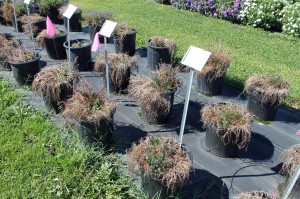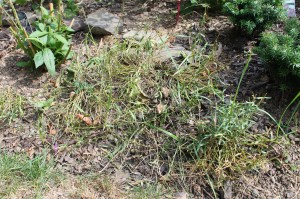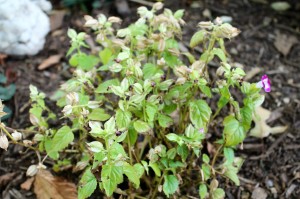Bottom 10 Annuals
September 17th, 2013
I spend a lot of time telling people about my favorite plants and some of the best new or under-used varieties worth trying.

It’s not just me. Here’s what the pots of lobelia look like at Penn State’s Trial Gardens in August.
What I don’t spend as much time talking about is plants at the other end of the spectrum – the wimps, the bug magnets, the feeble bloomers, the uglies and the easy-to-kills.
Knowing those can be just as helpful at plant-picking time as knowing the latest and the greatest.
So for the next three weeks of fall-planting season, I thought I’d share my opinions on the dogs of the central-Pennsylvania landscape world.
I’ll start with my “Bottom 10 Annual Flowers” today, move on to my “Bottom 10 Perennials” next week, and finish off with my “Bottom 10 Shrubs” the week after that.
Just because a plant has made the list doesn’t mean I’m saying you should never plant it. It also doesn’t mean I hate these plants or that I’ll hold you in disrepute if I see any of them growing in your yard.
I’m sure your lists would be different. In fact, feel free to fire away with your own non-favorites by hitting the comment button at the bottom of this list.
The 30 plants on my three lists come from my own personal experience with them and the assorted faults and shortcomings I observed that were enough to convince me to cross them off my “would-plant-again” list.
So for what it’s worth to you, here’s my pick of Bottom 10 Annual Flowers:
1.) Pansies and violas. I can’t keep either of these out of the rabbits’ mouths for more than 5 minutes after I plant. Which is just as well because the ones I’ve struggled to protect fry to a crisp by July anyway… even the supposedly heat-tolerant ones.
2.) Lobelia. These dainty bloomers look so enticing in the greenhouse with their deep blue flowers. But like pansies, they don’t like our summer heat and at the least shut down flowering – if not croak altogether. At least the rabbits don’t eat them.
3.) Annual phlox. These don’t die in summer, but I wish they would to be put out of their misery. They flower great early in the season, then figure they’ve earned enough respect and just quit. In my opinion, too many other annuals bloom from May to frost to spend money on half-season performers.
4.) Gazania. Gesundheit. Besides the name that reminds me of a sneeze sound, gazania only open when the sun’s out. Their daisy-like flowers are beautiful and showy, but what’s the point if they’re going to stay shut half the season? Rabbits also find them tasty – open or closed.
5.) Nemesia. Here’s another flower that looks great in a spring pot with their orchid-like spiky flowers. By July, though, it’s in suffer mode. Breeders keep trying to come up with a variety that blooms as well in summer as in spring and fall, but I haven’t seen a winner yet. Go with angelonia instead for this style of flower.
6.) Dianthus. Same story as annual phlox. Nice in spring, sorry by summer. Also potential rabbit food.
7.) Red salvia. I never learn with this one. I keep buying them because they attract hummingbirds and have such cheery red flowers in May. But by mid-summer, the red has turned to brown and very few new buds are bringing up the rear. Some people have luck with these. I don’t. Blue salvia is way better for me.
8.) Snapdragons. Again, it’s the heat that shuts down flowering in summer. A few newer varieties do a little better than older types, but snaps have been consistent under-performers for me in summer when an annual really should be at its best.
9.) Torenia. The so-called “wishbone flower” got a little better-known as a shade alternative to impatiens, which got hammered by a deadly new downy mildew disease last summer. I tried torenia several times in past years and was always unimpressed at the species’ flower power. So I stopped planting them. Given the impatiens situation, I tried again this year and got the same result as before. This one has breeding potential, but no one’s come close to the jackpot yet, from what I’ve seen.
10.) Nicotiana. No worries with the rabbits eating flowering tobacco. But like red salvia, this one starts nicely out the greenhouse gate but quickly but doesn’t seem to have much of a game plan for continuing to produce flower buds in real-life ground conditions. A spattering of new blooms mixed among the browned greenhouse blooms doesn’t cut it in my garden.
So what’s better? Check out my Plant Profiles section for rundowns on a few dozen of my favorite annual flowers, including pictures.
Also see my list of Bottom 10 Perennials and my list of Bottom 10 Shrubs.









